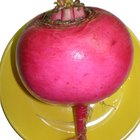AnnaIleysh/iStock/GettyImages
A Quick and Easy Step in Preparation
Beets, beloved for their sweet, earthy flavor, are very dense by nature and require blanching prior to some other preparations. You might simply want to blanch them briefly so you can peel them, for example, or to prepare them for freezing. For pickling or use in a casserole, a longer blanching time par-cooks the beets and breaks down the density of their fibers and helps the sauce or pickling liquid infuse into the vegetable. The process is much the same, whatever your goal.
Blanching Beets
You'll need a large pot of boiling water to blanch the beets, so it's best to shoo kids and pets out of the room beforehand. Here's how the blanching process breaks down:
Bring your pot of water to a full rolling boil. While it's heating, fill a large bowl with ice and water to make an ice bath for the blanched beets. Set it aside.
Rinse any dirt from the beets, and remove the greens - if present - and the tips of any extra-long roots. If you're blanching the beets to freeze or par-cook them, peel them as well with a sharp paring knife or a vegetable peeler. If your intended use doesn't require whole beets, you can cut beets of 2 inches' diameter or more into halves, and large beets of 3 inches or more into quarters.
Drop a few beets at a time into the pot, until the water drops below a boil. Bring it back to a full rolling boil, and heat the beets as long as your current use demands.
Remove the beets with slotted spoon and carefully drop them into ice water bath. Once cooled, drain the beets in a colander. Repeat for the remaining beets, replacing the ice water as needed to keep it cold.
Appropriate Blanching Times
If your goal is simply blanching beets to remove their skin, they don't need to stay in the water longer than a minute or two. That's long enough to soften and loosen the skins, which will then slide off easily and leave a beautifully smooth surface underneath. Blanching beets for freezing takes 2 to 3 minutes as well, just long enough to de-activate the natural enzymes that would otherwise start breaking the beets down. If you're par-cooking for salads or pickling, baby beets or cut-up beets might require as little as 5 minutes or as long as 10 to 15, depending how tender you want them to be.
A Few Tips
Beets, especially the most common red beets, are intensely pigmented and will stain anything they touch. When peeling, cutting and transferring beets from water, be sure to use dark towels to keep them from discoloring lighter kitchen towels, and use gloves to keep from discoloring your hands. Wearing a bib-type apron is a good idea, as well. If your beets come with green, leafy tops, don't discard them: You can cook those as you would chard or spinach, and use them as a side dish at your next meal.
Related Articles

How to Roast Beets for Canning or ...

How to Can Beets With Sugar & Vinegar

How to Freeze Fresh Beets

How to Roast Turnips

How to Steam Cook Cabbage

How to Cook Jerusalem Artichokes

How to Boil a Bell Pepper Before Baking

How to Preserve Rutabagas

How to Juice a Daikon Radish

How to Blanch Cucumbers

How to Cook Small Dutch Yellow Potatoes

How Long Do You Boil Baby Artichokes?
Can I Freeze Cubed Root Vegetables?

How to Store Carrots in the Refrigerator

How to Peel Raw Beets

Can You Freeze Uncooked White Potatoes?

Can You Freeze Cut Carrots, Broccoli & ...

How to Cook Mixed Greens
How to Cook Baby Carrots

How to Roast Beets on the Grill
References
- Eating Well: How to Pickle Anything
- Larousse Gastronimique; Genevieve Beullac
Tips
- Beets, especially the most common red beets, are intensely colored and will discolor anything they touch. When peeling, cutting and transferring beets from water, be sure to use dark towels to keep them from discoloring lighter kitchen towels, and use gloves to keep from discoloring your hands.
- If your beets come with green, leafy tops, use as you would chard or spinach rather than throwing them away.
Writer Bio
Christi Flaherty has been writing food blogs since 2005 and has been a featured publisher with Daily Buzz Food since 2010. Though she has cooked since she could walk, she dedicated her career to all things food after attending a two-week course at the Culinary Institute of America in Napa Valley.